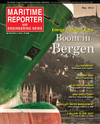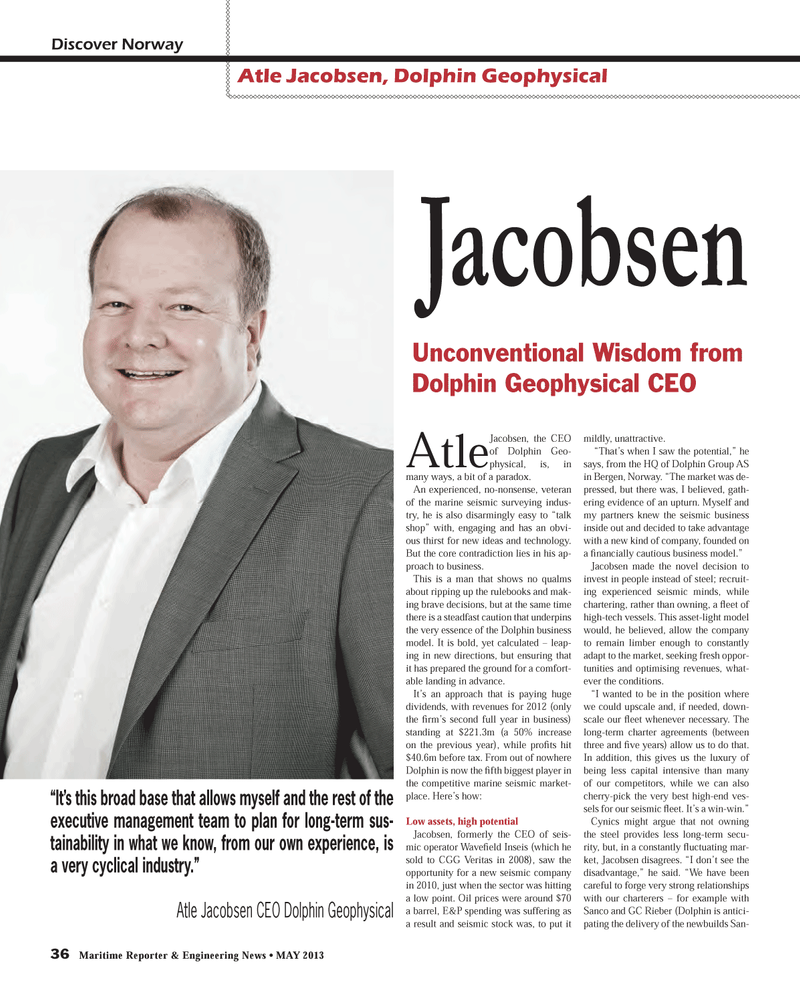
Page 36: of Maritime Reporter Magazine (May 2013)
Energy Production & Transportation
Read this page in Pdf, Flash or Html5 edition of May 2013 Maritime Reporter Magazine
36 Maritime Reporter & Engineering News ? MAY 2013 Atle Jacobsen, the CEO of Dolphin Geo-physical, is, in many ways, a bit of a paradox. An experienced, no-nonsense, veteran of the marine seismic surveying indus-try, he is also disarmingly easy to ?talk shop? with, engaging and has an obvi-ous thirst for new ideas and technology. But the core contradiction lies in his ap-proach to business. This is a man that shows no qualms about ripping up the rulebooks and mak-ing brave decisions, but at the same time there is a steadfast caution that underpins the very essence of the Dolphin business model. It is bold, yet calculated ? leap-ing in new directions, but ensuring that it has prepared the ground for a comfort-able landing in advance. It?s an approach that is paying huge dividends, with revenues for 2012 (only the Þ rm?s second full year in business) standing at $221.3m (a 50% increase on the previous year), while proÞ ts hit $40.6m before tax. From out of nowhere Dolphin is now the Þ fth biggest player in the competitive marine seismic market-place. Here?s how: Low assets, high potentialJacobsen, formerly the CEO of seis-mic operator Wave Þ eld Inseis (which he sold to CGG Veritas in 2008), saw the opportunity for a new seismic company in 2010, just when the sector was hitting a low point. Oil prices were around $70 a barrel, E&P spending was suffering as a result and seismic stock was, to put it mildly, unattractive. ?That?s when I saw the potential,? he says, from the HQ of Dolphin Group AS in Bergen, Norway. ?The market was de- pressed, but there was, I believed, gath-ering evidence of an upturn. Myself and my partners knew the seismic business inside out and decided to take advantage with a new kind of company, founded on a Þ nancially cautious business model.? Jacobsen made the novel decision to invest in people instead of steel; recruit-ing experienced seismic minds, while chartering, rather than owning, a ß eet of high-tech vessels. This asset-light model would, he believed, allow the company to remain limber enough to constantly adapt to the market, seeking fresh oppor- tunities and optimising revenues, what-ever the conditions.?I wanted to be in the position where we could upscale and, if needed, down-scale our ß eet whenever necessary. The long-term charter agreements (between three and Þ ve years) allow us to do that. In addition, this gives us the luxury of being less capital intensive than many of our competitors, while we can also cherry-pick the very best high-end ves-sels for our seismic ß eet. It?s a win-win.? Cynics might argue that not owning the steel provides less long-term secu-rity, but, in a constantly ß uctuating mar- ket, Jacobsen disagrees. ?I don?t see the disadvantage,? he said. ?We have been careful to forge very strong relationships with our charterers ? for example with Sanco and GC Rieber (Dolphin is antici-pating the delivery of the newbuilds San-Discover NorwayAtle Jacobsen, Dolphin GeophysicalJacobsen Unconventional Wisdom from Dolphin Geophysical CEO?It?s this broad base that allows myself and the rest of the executive management team to plan for long-term sus-tainability in what we know, from our own experience, is a very cyclical industry.? Atle Jacobsen CEO Dolphin GeophysicalMR #5 (34-41).indd 36MR #5 (34-41).indd 365/2/2013 9:43:52 AM5/2/2013 9:43:52 AM

 35
35

 37
37
